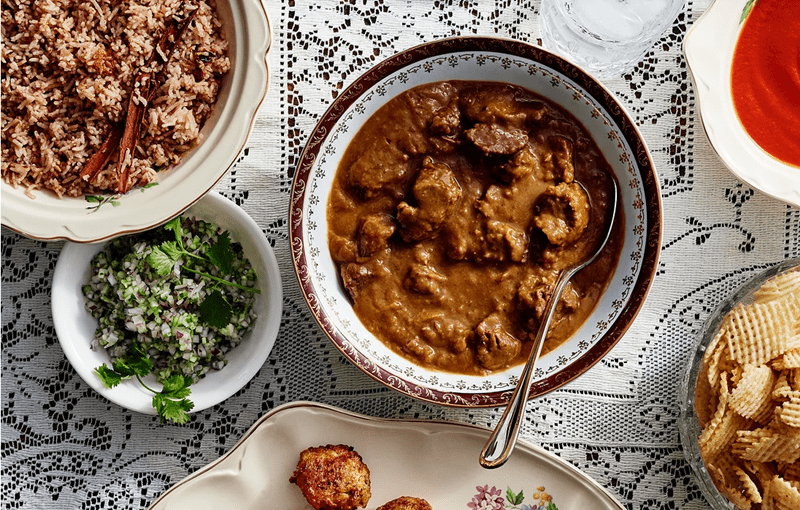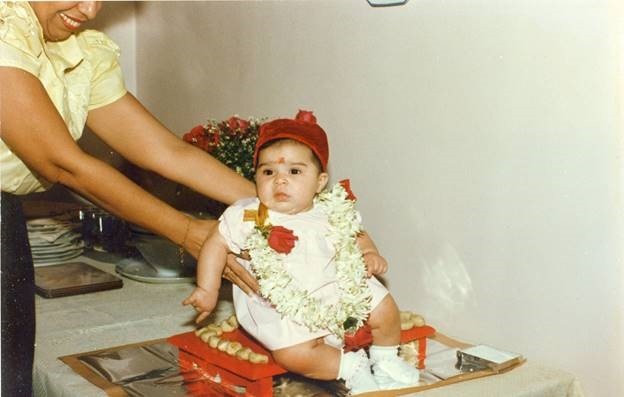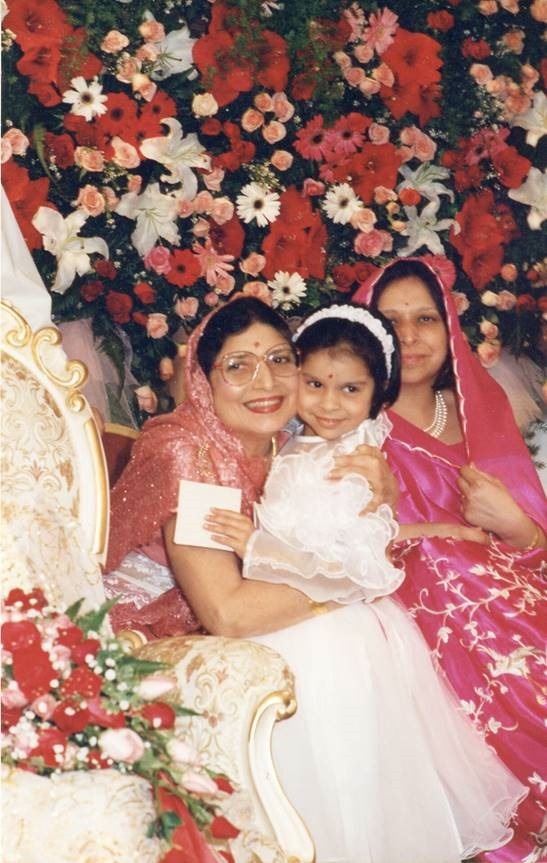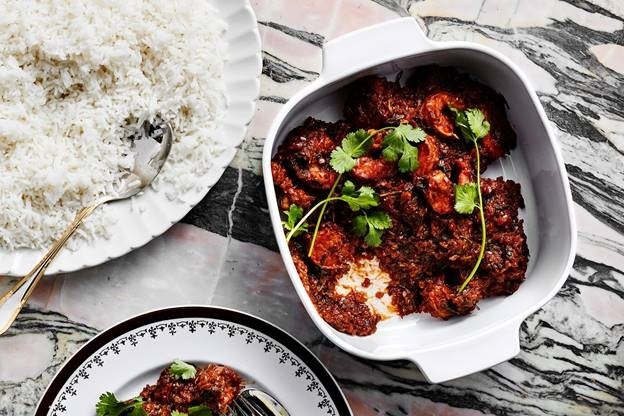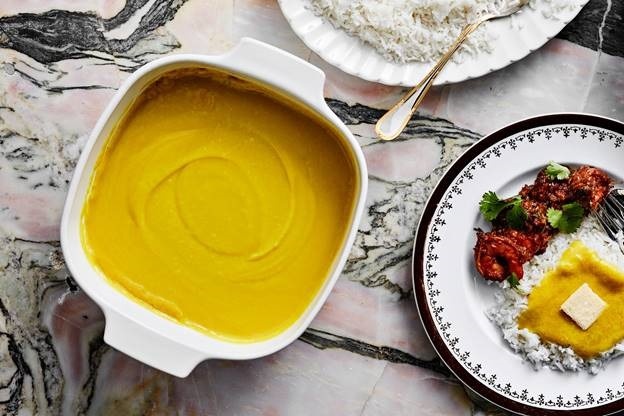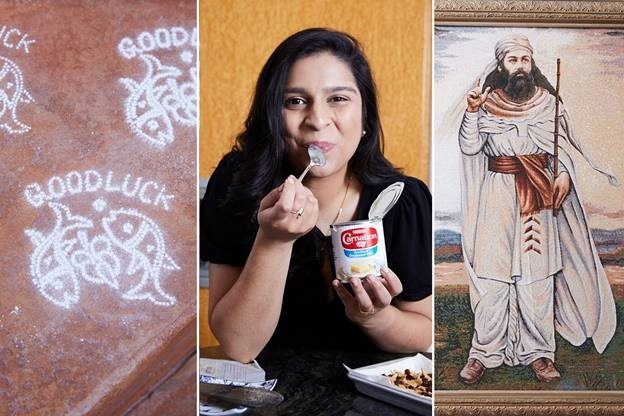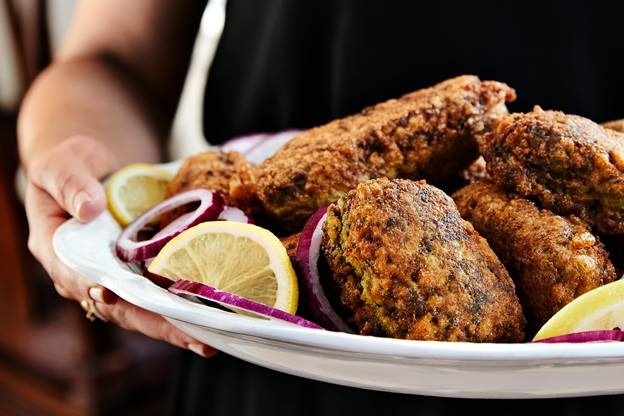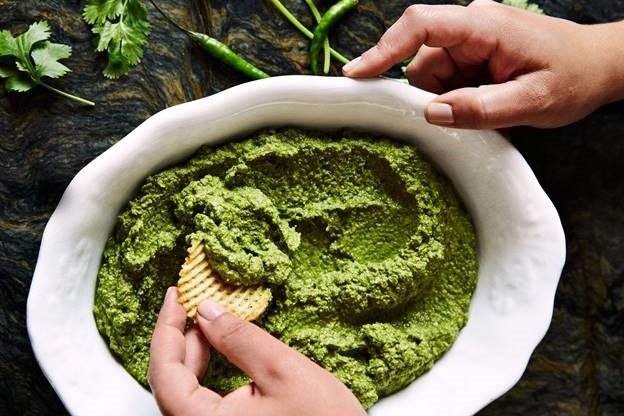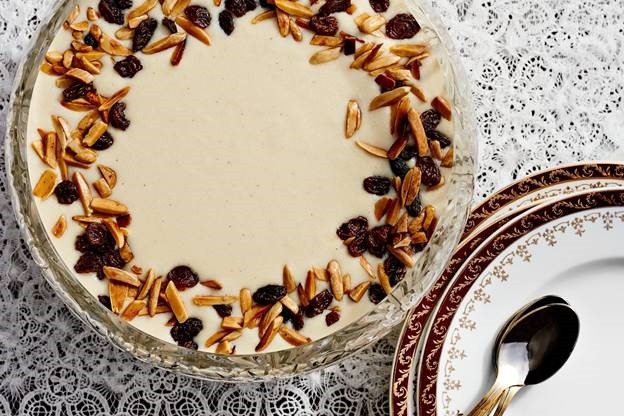Welcome to My Parsi Party
Parsis revel in their reputation as hedonistic gourmands. Every gathering, celebration, religious occasion, and even loss is marked by food. Writer Sabrina Medora shares never before printed recipes for the dinner parties of her childhood.
By Sabrina Medora | Food and Wine
February 19, 2021
NEWBORN BABIES IN MY PARSI FAMILY get a little mithu monu (sweets for the mouth) by way of a lick of ravo—a semolina porridge— from their mother’s finger to grant them a sweet nature. Doorways of our homes are marked with chalk outlines of fish for prosperity in the manner of the crown of Cyrus the Great. On special occasions, we ward off the evil eye by circling recipients’ heads seven times with eggs and then cracking them. Grains of rice are used to garnish vermilion dots on our foreheads. The vermilion signifies the sun and the moon; the rice grains are rays of light. They say the more rice that sticks to your forehead, the more bountiful your life will be. As a child, I would pick up fallen grains and stick them firmly to my forehead. I suppose it worked.
The author as a baby | Credit: Courtesy Sabrina Medora
More than a millennium ago, Zoroastrians fled Persia to escape persecution, and now we Parsis are one of the world’s smallest communities, perhaps well on our way to becoming classified as a tribe. And, yet, we have the most abundant outlook on life.The prophet Zoroaster, upon whose tenets our religion is based, asks us for three things: good thoughts, good words, and good deeds. None of which can be accomplished if we don’t eat, drink, and be merry. We revel in our reputations as hedonistic gourmands.
In sickness and in health, we eat dhan dar, a buttery concoction of turmeric and lentils served on white rice. The dish represents the humility with which we should accept both good and bad occasions. Upon the death of a loved one, we celebrate the gift of life. Prayer trays for the dead are accompanied by the favorite foods of those we pray for. During the pandemic, I honored the loss of both my beloved grandfathers with a bunch of ripe bananas and a packet of milk chocolate digestive biscuits near a lit tea light. I hope there’s plenty of both in heaven.
What am I saying? They’re Parsis. They’ll always find the food.
The author as a child | Credit: Courtesy Sabrina Medora
They’re Parsis. They’ll always find the food.
LIKE ANY FIRST-GENERATION immigrant to America, I spent most of my teenage and young adult years maintaining aloofness toward my roots. Now, as a 30-year-old married woman, separated by entire countries from my family in the midst of a pandemic, I’m left with vivid memories of dinner parties I spent in their company. Sometimes, I stand in my kitchen and close my eyes, allowing myself to be a child again.
A memory: I am 7 years old, in Mumbai, wearing a pretty pink party dress with ruffles sent with love from family in Singapore. I have been given two very important jobs this evening—turn on the air-conditioning at 6:30 p.m. sharp, and make sure the Camy Wafers chips make it from oven to crystal bowl while remaining piping hot.
Prawn Patio | Credit: Eva Kolenko
The air-conditioning switch is tucked away behind the rolling TV stand. I get on my hands and knees, jimmying my arm between the sofa and the stand, grab hold of the hefty switch, and, with a groan, flip it from down to up. The window unit above me grunts in response, humming to life. I stand, embracing a faceful of frigid air. The grandfather clock on the shelf sings its little ditty, marking the half hour. Thirty minutes leaves just enough time to cool the living room and dining room before the guests arrive. My patent leather party shoes slide across the freshly swabbed marble floors as I race to the infernally hot kitchen to shut the sliding doors, separating the cool party air from chaos.
The kitchen is bustling. My ayah, Mary, who looked after me from birth, and my mother waltz around each other stirring dals, fluffing rice, and smacking dough onto the counter. A white plate with delicate pink flowers holds perfectly cubed cheese adorned with cellophane-tipped toothpicks. A scattering of salted roasted cashews and plain almonds surrounds the cheese. “Put this on the coffee table,” my mother says as she thrusts the plate into my hands. As the youngest, it will be my duty to rotate each of the cocktail snacks to our guests, while answering questions about school and friends in a polite manner that makes my grandparents beam. I carefully practice holding the weight of the tray as I slide back out to the cooler side. It’s almost 7 p.m., and my mother hastens to her bedroom to dab the sweat off her forehead and change into a colorful ensemble.
Dhan Dar | Credit: Eva Kolenko
The doorbell chimes, and family begins to stream in. The hall is soon filled with the scent of Yardley soap and whiskey. “Can I get you a drink?” my father offers and waits patiently as the guest pretends to debate one of three options—whiskey, beer, or a nice fizzy Coke. There’s fresh coconut water from the fruits of a tree outside our building, picked that morning, for the more reserved guests and me.
After my rounds, I nestle between my father’s feet, looking up at his fancy rocks glass, and whisper, “Just one sip?” When he finally says, “No more,” I repeat the routine with my grandfather. My mother eyes me, and I know it’s time for the chips. I make my way to the kitchen, sliding the door barely a crack open to squeeze myself in without allowing the heat to escape. Mary has been joined by another ayah, who is deftly rolling balls of atta into chapati. I sneak one from the tray and pop it into my mouth, quickly pressing it flat with my tongue so as not to be caught out. It doesn’t work, and I get a light smack on my bottom. I chew, smiling. The illicit excitement of raw dough is always worth it.
Arré, greedy pop. Go on, serve!
“Take it carefully now, hear?” Mary lowers an ornate crystal bowl into my arms, heaped with waffle-cut potato chips piping hot from the oven. I inhale, my mouth watering with the tease of salty oil. I lower my mouth to the bowl and gently pluck a chip off the top. I chew with my mouth open, simultaneously eating and cooling the chip. “Arré, greedy pop. Go on, serve!” Mary sharply turns me to the door, and I’m back in the hall. I make my rounds, impatient for the adults to take their share so I may have mine. The hot appetizers will be coming soon.
Credit: Eva Kolenko
Adult conversation is boring, and the chips go fast. A subtle flick of my mother’s head tells me I’m welcome to make a silent exit. I hustle back to where the real action is and settle on a chair in the kitchen—the best seat in the house. Uproarious laughter wafts through the door, but I feel no fear of missing out. I’m exactly where I want to be, within prime reach of the dhansak. I pluck a leftover chip from the bag, unbaked and still greasy with oil. When Mary’s head turns, I strike, landing my treasure, a glistening piece of mutton enrobed in thick, spicy dhansak dal.
I shove the whole thing in my mouth and massage my jaw so that it doesn’t lock while claiming this prize. My father enters the kitchen under the pretext of getting more Coke from the fridge. (Who do you think I learned my moves from?) I offer him a chip. Dhansak is usually reserved for leisurely Sunday afternoons and family gatherings, which means we truly dedicated fans of the dish do our best to sneak the best bits of mutton before the rest of the family can get to it.
Chutney Fish | Credit: Eva Kolenko
The siren song of the rest of the dishes soon lures me to other parts of the kitchen counter. I stare as Mary flips thick pieces of fried fish from the tawa to a paper-lined tray. Oil shimmers, dripping across the crags and crevices of the breadcrumb coating, bits of green chutney peeking through. The egg, applied after the breadcrumbs instead of before, adorns each piece of fish in a lacy fried tutu. My hand gets smacked as my fingers inch forward, and I look up at Mary, wounded. She rolls her eyes and silences me with a fresh chapati, still ballooning from the fire. I poke my finger through the now-cooked dough and watch steam puff out until it cools enough to wrap into a tight pinwheel and munch. I choose a new dip—cinnamon-infused tomato gravy that will accompany ground beef cutlets. The cinnamon reminds me of my grandmother in Singapore. I take a bite for her.
“Chalo, go tell mama dinner is ready,” Mary says, shooing me from underfoot. I finish my last purloined bite and take a swig from an open Coke bottle to cleanse my palate for what is to come.
GET THE RECIPE: GROUND PORK CUTLETS WITH TOMATO GRAVY
Jolly good show, jolly good!
ALL THESE YEARS LATER, for the first time in my life, I’ve begun cooking the food of my community. It’s strange to do so now, alone. But, in the quiet of the kitchen, I can feel my grandmother standing behind me, in her housecoat, smiling as I stir condensed milk into butter and semolina to make the ravo recipe guarded by the women in her family for generations. Out of the corner of my eye, I can see my grandfather Umpa stealing one of the chapatis I’ve taught myself to flip and wrapping it around a banana with a grin. I welcome Papa, my other grandfather, as he does his bowlegged bustle into my kitchen to peer over my shoulder approvingly as another chutney fish earns its delicate crisp. He pats me on the back, and his voice echoes in my mind, “Jolly good show, jolly good!”
GET THE RECIPE: PARSI GREEN CHUTNEY
Green Chutney | Credit: Eva Kolenko
My mother’s voice guides me through texts and phone calls as I measure out just the right amount of chiles for my chutney. She calls for handfuls of this and dashes of that as I frantically flip through cookbooks to find a corresponding metric. My uncles and aunts cheer through group texts as I share photos of my dhansak before giving me the third degree on whether I used the “traditional” recipe or “took the easy route.” (I’ll never tell.) My father and still-living grandmother text me words of encouragement: “Looks good, we’ll see how it tastes one day.”
One day.
In the meantime, we pour wine and Scotch into glasses and toast tandorosti, meaning blessings for well-being, to our loved ones. We fill our homes with the scents of cinnamon, cloves, and chiles. We huddle over well-loved pots on stoves, scooping hunks of mutton and dal using potato chips as spoons. Through all odds, we seek and find happiness and healing through food and drink. We Parsis have done so for millennia—with the firm faith that our ancestors are joining in from above and around—and we will do so for millennia to come.
Ravo | Credit: Eva Kolenko
Welcome to my table.
These recipes, shaped by geographic and immigrant history, have been passed down verbally by generations of women in my family, each of whom added their own personal touch—including myself. This is the first time they are ever appearing in print. They can be enjoyed as stand-alone delights or, as the Parsis like to do it, a bumper feast. Tandorosti!

